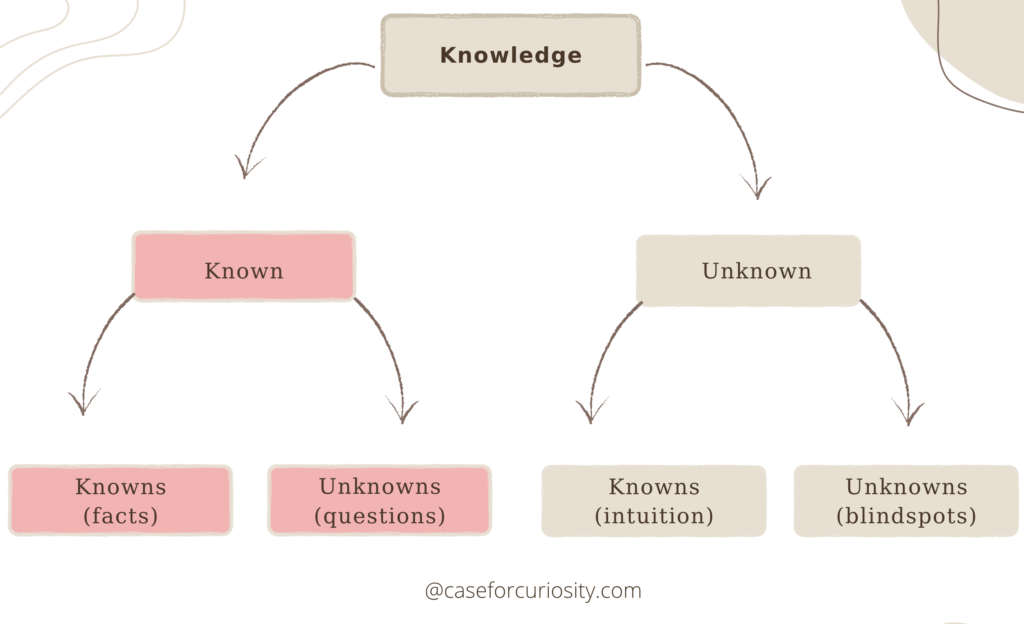A simple tool for managing risk and making better decisions
We all make decisions amidst uncertainty. Information is always incomplete, and no one can predict the future reliably. The uncertainty matrix can help here. In this post, I’ll explain this tool and offer some suggestions for applying it.
What is the uncertainty matrix?
The uncertainty matrix is a useful decision-making tool. It helps us organize information and categorize risk by sorting knowledge into four categories:
- Known Knowns: the facts
- Known Unknowns: questions
- Unknown Knowns: intuitions & undiscovered information
- Unknown Unknowns: blindspots
When I think about this framework I imagine sitting beside a campfire at night. I can see about ten feet in any direction, but beyond the reaches of the fire’s light is inky darkness that my eyes cannot penetrate. I think about everything I can see as the things I know, while my unknowns lay in the darkness. My job is to bring them into the light.

While the uncertainty matrix is a simple framework, it can yield surprisingly useful insights. It’s most commonly used in organizational planning and project management, but I think it can be a great tool for individual decision-making as well.
Where did the uncertainty matrix come from?
The uncertainty matrix is commonly attributed to former Secretary of Defense Donald Rumsfeld, but its core concepts have been around for a long time.
NASA uses the uncertainty matrix to assess risks in space exploration. This 2003 presentation is a great example of this tool in action. In the wake of the 2003 Columbia disaster, NASA needed to find ways to derisk future missions. They used the uncertainty matrix to shift information from the “unknown” categories to the “known” categories.
In the 1950s, cognitive psychologists developed a similar tool called the Johari Window to facilitate introspection and improve relationships.
Similar references to “known unknowns” and the like appear in the 1800s. 13th-century Persian poet Ibn Yamin wrote:
One who knows and knows that he knows…
His horse of wisdom will reach the skies.
One who knows, but doesn’t know that he knows…
He is fast asleep, so you should wake him up!
One who doesn’t know, but knows that he doesn’t know…
His limping mule will eventually get him home.
One who doesn’t know and doesn’t know that he doesn’t know…
He will be eternally lost in his hopeless oblivion!
Further back still, Socrates said: “The only true wisdom is in knowing you know nothing.”
Breaking it down

Known knowns: Facts
Known knowns are the things we know that we know, like the capital of the United Kingdom, that an election will be held next month, or the ingredients of our favorite chocolate chip cookie recipe. They are facts, and they will generally be the easiest information to grasp.
Application:
- Don’t take the facts for granted: scrutinize what you think you know.
- Justify it with evidence.
- Question the assumptions that your facts are built on. How do you know?
Known Unknowns: Questions
Known unknowns refer to the information we are aware of not knowing. For example, if we’re building a product, we may be aware that we don’t know what kind of user interface our users will find most engaging.
Known unknowns can be daunting, but the good news is that when we know what the gaps are, we can formulate them as questions and make a plan to address them. For example, though we don’t yet know what our product interface will look like, we can plan experiments to learn about how our users will react to different options.
Application:
- Formulate known unknowns as questions
- Develop hypotheses and plans to test them
- Prioritize your known unknowns. What is most important to resolve? What impact will not knowing this have?
Unknown Knowns: Intuition
“Unkown knowns?” you might be saying. “How could I know something but not realize it?”
It turns out we do this all the time as individuals. It’s called tacit knowledge and refers to the skills, ideas, and experiences we possess but can’t always write down or describe. An example is things we know to be true intuitively. We are often unaware of this knowledge, or how useful it can be to others, but we still know it.
Unknown knowns exist in organizations, too. When information is unevenly distributed, forgotten, or miscommunicated, knowledge exists, but awareness does not.
Application:
- Organizationally, think about the knowledge that exists, waiting to be discovered.
- What are customers saying? What are people working on the frontline seeing and saying? How can you collect their feedback?
- How can you incorporate design thinking techniques, like structured brainstorming, into your planning process?
Unknown Unknowns: Blindspots
Unknown unknowns are the things we don’t know that we don’t know. As individuals, these are our blindspots, and they pose the biggest threats to our goals because they are the things we can’t anticipate. For organizations, unknown unknowns are the surprises that no one saw coming: unexpected budget cuts, or unforeseen legal issues. However, this doesn’t mean that there is nothing that can be done.
Application:
- Develop scenarios and play them out. Don’t simply sketch out bad / medium / good. Imagine a wide range of possibilities. It’s healthy to throw some off-the-wall situations out and assign a probability to them.
- Build in contingencies. If you’re planning a project, you might set aside 10-15% of the budget for emergencies.
- Keep a flexible mindset. Planning is essential, but it’s important not to become too rigid. An awareness of unknown unknowns can help us maintain the flexibility we need to adapt to them when they inevitably come to pass.

